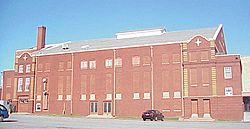Tulsa Theater facts for kids

Exterior view of the west end of the theater
|
|
| Former names | Brady Theater (1979-2019) Tulsa Municipal Theater (1952-79) Tulsa Convention Hall (1914-52) |
|---|---|
| Address | 105 Reconciliation Way Tulsa, OK 74103-7809 |
| Location | Tulsa Arts District |
| Owner | Peter Mayo |
| Capacity | 2,800 |
| Construction | |
| Opened | October 22, 1914 |
| Construction cost | $125,000 ($3.79 million in 2022 dollars ) |
| Architect | Rose and Peterson |
| Website | |
|
Convention Hall
|
|
|
U.S. Historic district
Contributing property |
|
| Architect | Curtin |
| Part of | Brady Historic District (ID10000618) |
| NRHP reference No. | 79002028 |
| Significant dates | |
| Added to NRHP | August 29, 1979 |
| Designated CP | September 3, 2010 |
The Tulsa Theater is a famous building in Tulsa, Oklahoma. It has been a place for shows and meetings for over 100 years. It was first built in 1914 and has been updated several times.
This historic theater is listed on the National Register of Historic Places. It is still used today for many different events. The theater was once called the Brady Theater. However, its name was changed in 2019. This change happened because the person it was named after, W. Tate Brady, had controversial connections in the past.
Contents
History of the Tulsa Theater
The Tulsa Theater has been an important public building since it opened in 1914. The city of Tulsa built it between 1912 and 1914. They used money from a special bond issue to pay for it. The building was first known as Convention Hall. It was designed by architects Rose and Peterson from Kansas City, Kansas.
When it first opened, the theater was one of the largest halls around. Some even said it was one of only 16 theaters in the U.S. that could host a full Metropolitan Opera show. Many famous opera singers performed here. For example, Mary Garden sang in Carmen in 1916. She returned in 1918 with the Chicago Grand Opera Company. Other stars like Tamaki Miura and Feodor Chaliapin also performed.
There is a local story that the theater is haunted. People say the ghost of famous singer Enrico Caruso is there. He performed in 1920 and supposedly caught a cold that led to his death.
During a difficult time in 1921, the building was used temporarily. It served as a place to hold people during the Tulsa race massacre.
Locals have given the theater several nicknames. These include "The Miracle on Brady Street" and "The Old Lady on Brady." It is also called "The Theater That Wouldn't Die."
What the Theater Looks Like
The Tulsa Theater is located at 105 West Reconciliation Way. It is a four-story building. It measures about 130 feet by 160 feet. The theater was designed to hold 4,200 people. This includes 1,300 seats in the balcony. The stage is very large, measuring 70 feet wide and 40 feet deep. It also slopes down from back to front.
The building once had a special pipe organ. It was the only one owned by a city west of the Allegheny Mountains.
Updates Over the Years
The Tulsa Theater has been updated several times. These changes helped it stay modern and useful.
1930 Renovation
In 1930, a famous architect named Bruce Goff helped redesign the inside. He had only 30 days to turn the large space into an elegant showplace. This was important because Tulsa was becoming known as "The Oil Capital of the World."
The updates included new curtains and seats. The walls were decorated with white plaster and gold lines. Air conditioning grilles were gilded, and the ceiling tiles were painted in different colors. Five large light fixtures were also added to the main auditorium.
1952 Additions
In 1952, new parts were added to the front and back of the building. New lobbies were built. At this time, the building was renamed the Tulsa Municipal Theater. The design style was called Western Classic Revival.
In 1978, the city of Tulsa sold the building. A local business owner, Peter Mayo, bought it. He has owned it ever since. In 1979, the building was officially listed on the National Register of Historic Places.
2020 Renovation
The business officially started calling itself the Tulsa Theater in January 2020. The owner, Peter Mayo, plans to reuse an old sign. This stainless-steel sign spells out "Tulsa" in a stylish way. It will have LED lights. This sign was on the building from 1952 to 1979. That was when the venue was known as the Tulsa Municipal Theater.
The Tulsa Theater continues to host many concerts and plays today. It is still a very important part of Tulsa's history and culture.
National Register of Historic Places Listing
The Tulsa Theater was first listed on the National Register of Historic Places on August 29, 1979. It was listed again in 2010. This second listing was as a contributing building within the Brady Historic District. This means it is an important part of a historic area.

